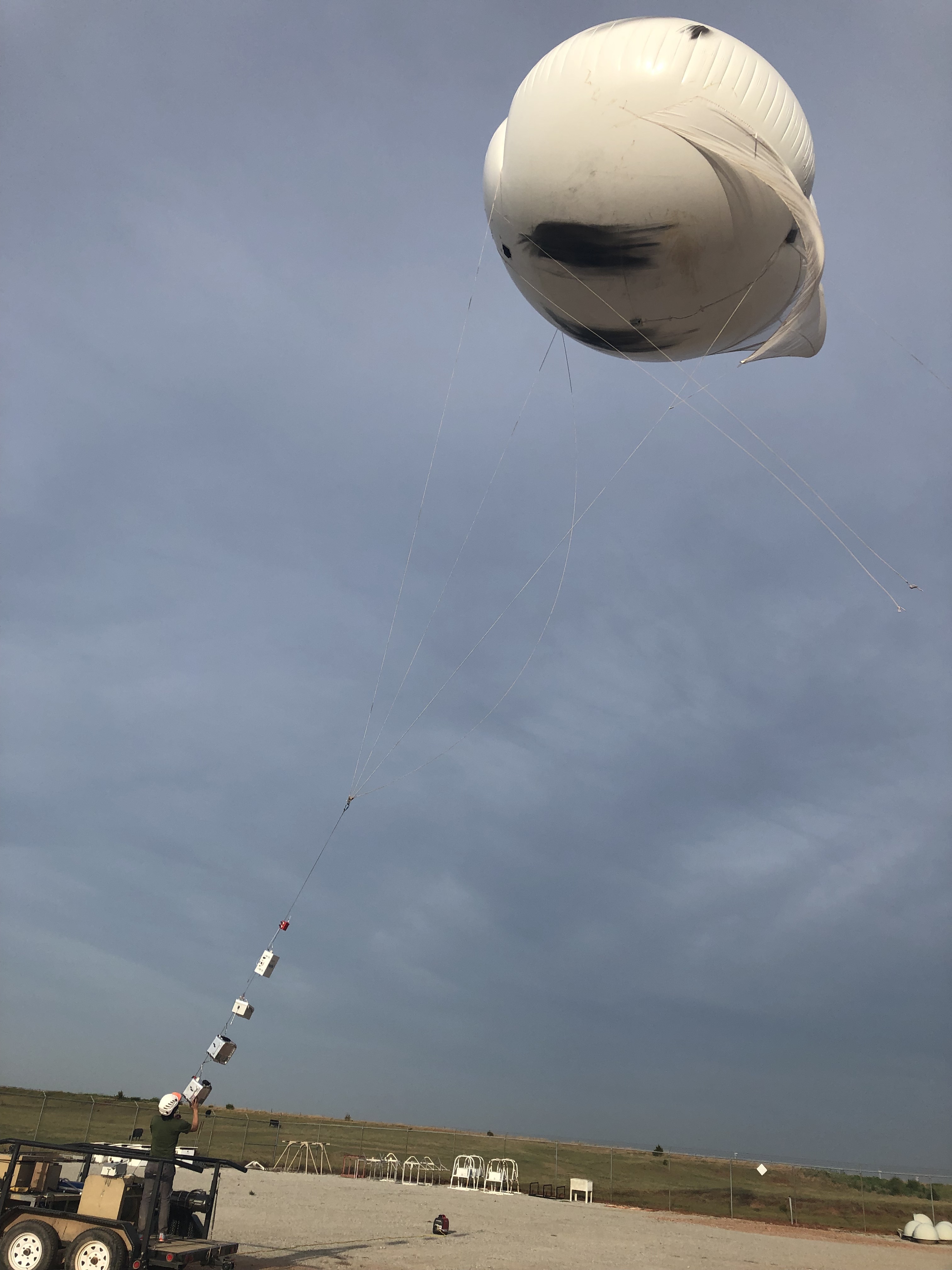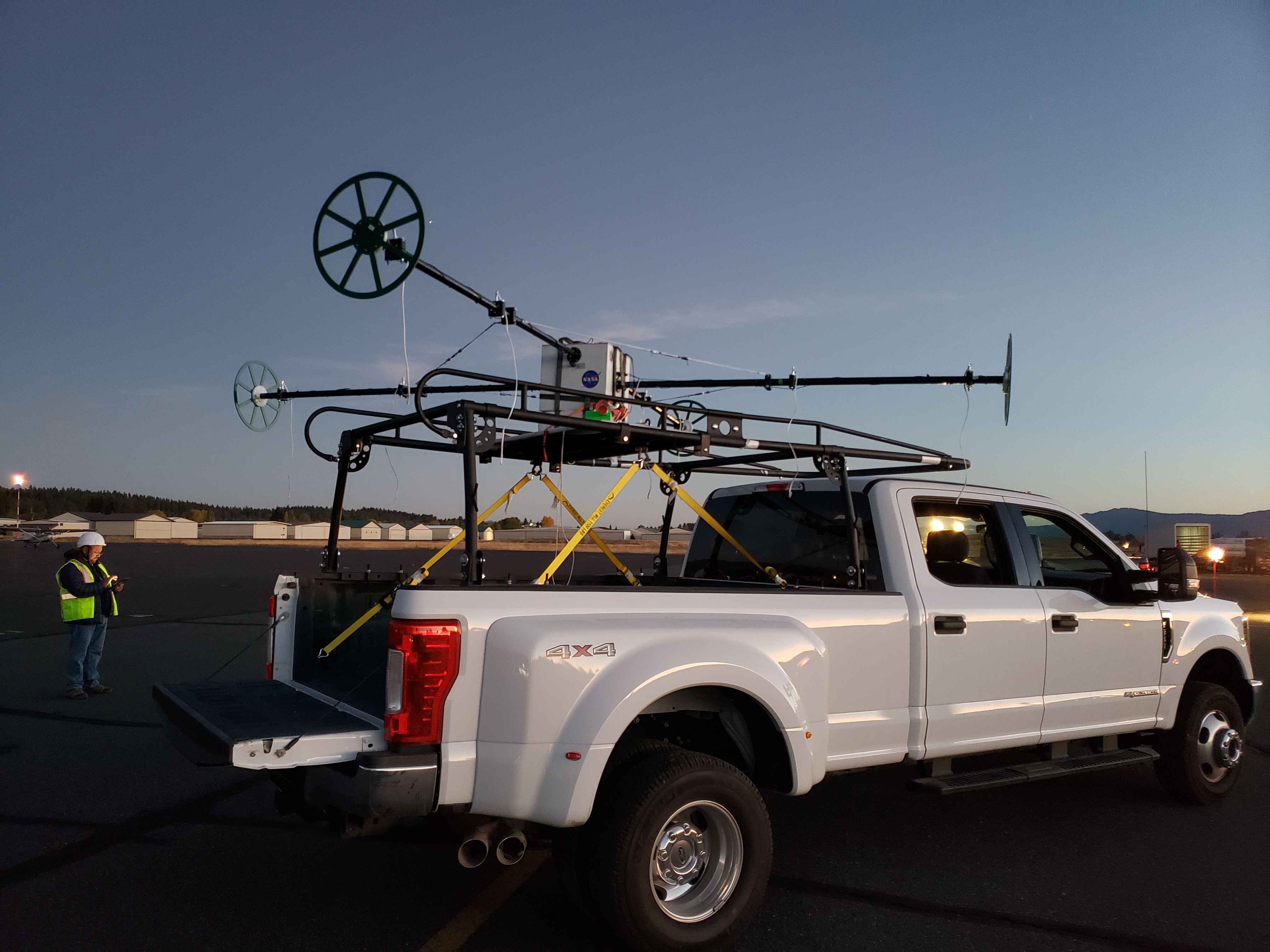ARM Helps High-Flying Science Happen in 2019
Published: 23 September 2019
Tethered balloon systems take to the skies above Alaska and the Southern Great Plains

It’s not unusual to see tethered balloons rising into the clouds above Oliktok Point, Alaska. The Atmospheric Radiation Measurement (ARM) user facility flies instrumented tethered balloon systems (TBS) in restricted airspace controlled by the U.S. Department of Energy.
In 2019, Oliktok saw 56 hours of TBS flight time in May and August. Measurements included temperature, wind speed, supercooled liquid water, and number concentration of aerosols (tiny particles in the air).
Expanding capabilities to new sites, ARM TBS flights also took place in 2019 over the Southern Great Plains (SGP) atmospheric observatory, more than 4,000 miles southeast of Oliktok. The first flights happened in April.
Following an ARM proposal call, the SGP hosted guest instruments on TBS flights in July. One more set of guest instrument flights is scheduled there at the end of September.
“One of the things that’s generally understood is that particle concentration decreases with increasing altitude, but that’s not really well quantified,” says Dari Dexheimer, an atmospheric scientist from Sandia National Laboratories in New Mexico who coordinates the ARM TBS flights. “I think we already are learning a lot about that just from the measurements we took in July.”
ARM-EMSL Collaboration Reaches a New Level
ARM and another U.S. Department of Energy scientific user facility, the Environmental Molecular Sciences Laboratory (EMSL), paired their capabilities to develop and test an aerosol filter sampler for TBS flights. This project will provide the foundation for an upcoming joint ARM-EMSL call.
“At the current point,” says Fan Mei, ARM Aerial Facility science manager, “there’s no miniaturized instrument that can give us scientific-quality data of chemical composition on a tethered balloon, so that’s why we started with some offline analysis capability.”
“At the current point, there’s no miniaturized instrument that can give us scientific-quality data of chemical composition on a tethered balloon, so that’s why we started with some offline analysis capability.”
Fan Mei, ARM Aerial Facility science manager
Information from this type of analysis could help improve understanding of aerosol-cloud interactions, including how different particles contribute to cloud formation.
Mei and EMSL chemist Swarup China modified a commercial multistage impactor that separates particles into different size classes at each level of the device. They applied a substrate at each stage of the impactor, catching the largest particles at the top level and the smallest at the bottom. Mei also designed an inlet system for the impactor to capture atmospheric aerosols while on the TBS.
Impactor flights took place in July at the SGP and in August at Oliktok. China is analyzing the filtered samples back at EMSL.
For the SGP, he is focused on particles gathered during biomass burning and dust events around the observatory. During preliminary analysis, China saw a surprising number of large dust particles collected at higher altitudes.
As expected, initial analysis showed a substantial number of carbonaceous particles in the biomass burning samples taken from the upper atmosphere.
“It’s good to see at the same time how much,” says China. “You can investigate the detailed chemistry of these particles.”
China says the plan is to present results in December at the 2019 American Geophysical Union Fall Meeting in San Francisco, California. The ARM-EMSL team is also building a sampler to deploy next year at the SGP and Oliktok.
“We are trying to make a sampler that is both size- and time-resolved,” says China. “So we can program it and, say, sample for 20 minutes and go to the next sample, so we can have a better picture of the vertical profile of aerosol composition.”
Targeting Ultrafine Particles

The TBS team deployed two guest condensation particle counters (CPCs) for the Vertically Resolved New Particle Formation and Transport Study (VNATS), led by Chongai Kuang of Brookhaven National Laboratory in New York.
Historically, measurements of ultrafine aerosols have been mostly made at the surface. However, a recent study at the SGP indicated that these particles were forming about 400 to 600 meters (about 1,312 to 1,969 feet) above the surface.
“One of the questions we want to answer in this study is: Is what we’re measuring at the surface actually representative of what’s happening throughout the boundary layer?” says Kuang.
CPCs operate by condensing alcohol (e.g., butanol) or water onto particles so they grow large enough to be detected by optical scattering. ARM’s CPC, which uses butanol as its working fluid, is considered a fine CPC because it can detect particles as small as 10 nanometers in diameter. However, Kuang modified his water-based CPCs to achieve ultrafine particle detection down to 5 and 2 nanometers to more directly measure the size distribution of newly formed particles.
Kuang’s CPCs flew at the SGP in July at the same time as the ARM-EMSL aerosol impactor. For VNATS, the TBS performed vertical profiling by moving up and down within the boundary layer, so the CPCs could capture the ultrafine aerosols where they might be forming. Early data analysis showed high particle concentrations aloft at 500 meters (about 1,640 feet) that were associated with the burning of nearby agricultural fields.
Kuang will deploy the CPCs again at the end of September and plans to propose another round of flights for spring 2020.
“There is a seasonality to the formation of these ultrafine particles at the surface,” he says, “and the peak formation frequency happens in the spring.”
New Frontiers

Bob Grimm, an earth scientist at Southwest Research Institute in Boulder, Colorado, drove out to the SGP in July to fly a Balloon-borne, Transverse Electromagnetic Measurement (BTEM) instrument.
“What we’re trying to do is test a method of measuring natural electromagnetic waves that penetrate into the planet and tell us the properties of the inside of the planet,” says Grimm.
The BTEM instrument consists of a box with booms jutting out from four sides and a wagon wheel at the end of each boom. The booms contain footlong coils that measure the magnetic field. Changes in the electric field, or voltage drops, are measured between electrodes—the wagon wheels—on opposite ends of the device.
Grimm also measured the magnetic and electric fields at the surface.
“Comparing the properties at the different altitudes to what I got on the ground measurement is going to be what really shows how well this thing works,” he says. “The only thing I had to worry about on the ground experiment were the cattle. They were very inquisitive.”
The eventual hope is that a BTEM instrument could fly in the atmosphere of Venus, which is often called Earth’s twin because they are similarly sized planets made of the same rock and metal. Earth gets rid of its heat energy through plate tectonics, but Venus’ heat engine is a mystery.
A ground instrument would not last long on Venus. Its surface is about 800 degrees Fahrenheit, and high-altitude wind can exceed 200 mph. An instrument would be far likelier to survive in Venus’ atmosphere, where the pressure and temperature are far more comparable to Earth’s surface.
“I’m hoping that the ARM experiment is the keystone of our experiment and that, based on these results, we’ll be able to write more proposals for advanced instrument development and then a mission to Venus,” says Grimm.
Ready to Propose?
A new proposal call is open for guest instruments to fly at Oliktok or the SGP in 2020. Submit your proposals now.
Keep up with the Atmospheric Observer
Updates on ARM news, events, and opportunities delivered to your inbox
ARM User Profile
ARM welcomes users from all institutions and nations. A free ARM user account is needed to access ARM data.


















